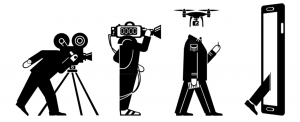The third issue of Found Footage Magazine is now available, with 19 articles on over a dozen filmmakers and topics. Full contents of the new issue can be found at Found Footage Magazine. But there are a couple of items of particular interest for this blog:
“What Images Show, What Images Conceal: Harun Farocki and the Archive,” an essay by Sergei Álvarez Rosalido. One sample line: “The image, which should convey reality, actually removes reality from perception.”
And a conversation between myself and Alejandro Bachmann of the Austrian Film Museum on video essays as found footage practice.
Sample excerpt:
A.B.: As someone who has made over 300 video-essays and who sometimes publishes a new one each week, I would pressume that the aspect of finding, which is so central to the concept of found footage, differs from a normal viewing experience. In how far are you already searching for something and in how far do you manage to let go of this need to produce a video essay and actually just watch the film and be sensitive to the experience of watching it?
K.B.L.: I can appreciate the underlying sentiment of this question, to watch something without feeling the need to produce something from it, whether it be a video essay, or a written review of appreciation, or these days, a .gif or a screenshot to post on social media. This distinction draws critical attention to contemporary viewing experiences of cinema and media as a new form of labor, as opposed to leisure, as we might typically understand past forms of film and television viewing.
This collapsing of labor and leisure takes place in the factory-playground of social media, where companies like Facebook and Twitter profit from employing an unsuspecting workforce of billions engaged in the constant, casual production of media. It’s a form of labor that many of us find addictive, in that we are continually in a state of self-reflexive curation of our lives, so as to produce the most desirable representations of them to share with others. This includes our experiences of the films and media we watch. Just as we may enter a state of meta-awareness of our lives for the sake of packaging it for others’ consumption, we do the same these days with movies and media.
I confess that these days a lot of my movie viewing is tied to the production of video essays, and it is often the case that I might not watch the entirety of a film, but scan it for segments to give special attention, if the purpose is to find material to produce a video essay on say, a visual motif that appears in different films, or an actor’s performance tendencies. I wonder if this is so wrong, when this mode of producing new insights into movies results in the production of new approaches to viewing (both in the making of the video and in the audience’s reception of it). I think this is endemic of how new modes of viewing emerge from new norms of media culture.
I do occasionally “just watch the film” when there’s an (increasingly rare) opportunity to do so. Given the prevalence of this kind of labor-intensive viewing, it may be that the act of watching the film simply to watch it without the need for it to be “productive” might be the more radical gesture, at a time when work’s increasing encroachment into our leisure activities ought to be drawn into question.
The full issue can be ordered at Found Footage Magazine.
